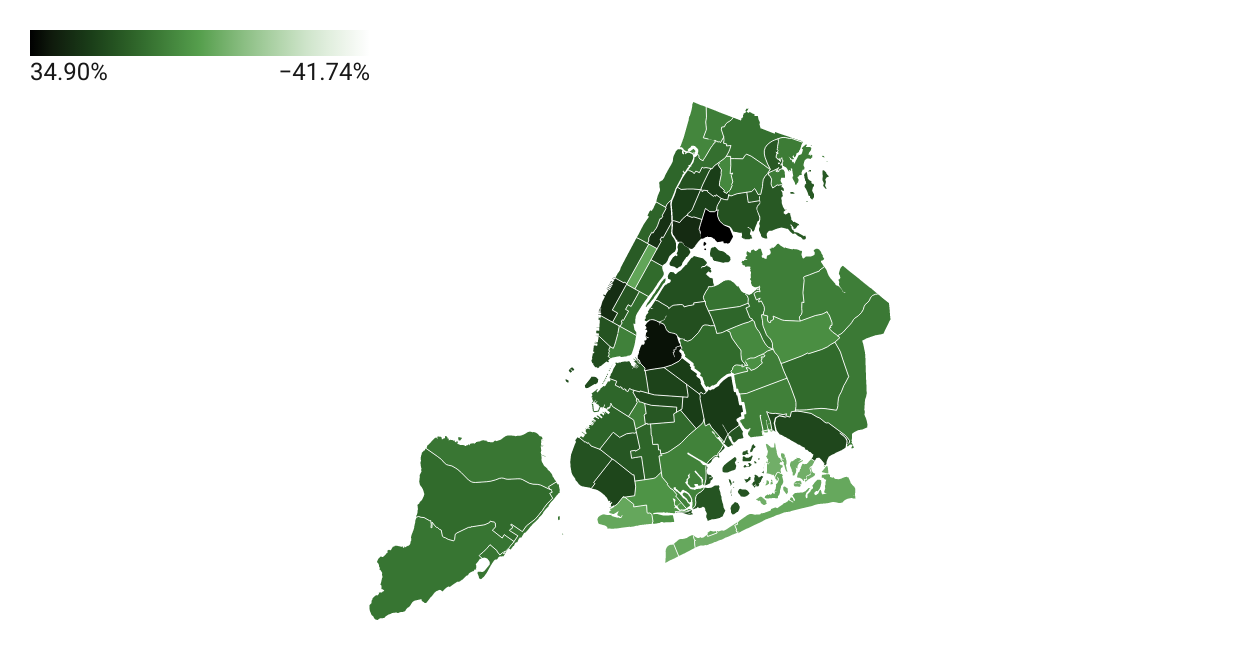A tree grows in the South Bronx. In fact, thousands of them!
The South Bronx, a heavily industrial residential area and home to “Asthma Alley,” has become shadier at a faster pace than any other section of the city over the past eight years, according to data published in a new report, The State of the Urban Forest in NYC.
Mott Haven, Melrose and Port Morris showed a 2.97% increase in tree canopy between 2010 and 2017, and Hunts Point and Longwood had a 2.16% growth, as a result of new trees planted and younger trees becoming older, according to the report, published by The Nature Conservancy. The citywide average is 1.72%.
“Growing up in New York where we’re always in a hustle and bustle of moving, I feel like green areas and trees give you a sense of peace,” said Lovelyn Morfaw, a Bronx resident who believes even more trees are needed in the area.
The South Bronx is among the many Black and Brown low-income neighborhoods that are negatively affected by air pollution and the lack of green spaces, resulting in urban heat islands and high asthma rates. The South Bronx is also constantly flooding due to the vulnerability of the peninsula during hurricane season. Trees often help with these problems, which residents have been battling for decades.
“There are well-established social and biophysical benefits of urban forests,” said Lindsay Campbell, a research social scientist from the U.S. Forest Service. “They provide known ecological benefits—cooling the air, providing shade, absorbing stormwater. But they are also critical sites for fostering local engagement through planting, care, stewardship and education practices.”
The Bronx had the highest percentage of children up to 12 years old who have been diagnosed with asthma, according to New York City Child Health’s 2015 Emotional Wellness and Development Survey. With Mott Haven known as “Asthma Alley” and more than 12% of adults in Hunts Point living with asthma, the South Bronx has one of the highest rates of asthma in the country, according to the Centers for Disease Control and Prevention.
“Urban forests help absorb air pollution,” said Mike Treglia, lead scientist for the Cities Program with The Nature Conservancy in New York and co-author of the report. The US Department of Agriculture’s forest service estimated in 2010 that 17,000 health impacts or health effects from air pollution have been avoided as a result of the urban forest, Treglia said.
Extreme heat is also an issue for the region and for the country as a whole — it is the leading weather-related cause of death, according to the National Oceanic and Atmospheric Administration.
South Bronx Unite collaborated on an urban heat island index study this past summer with Columbia University and the National Oceanic and Atmospheric Administration. The study found that the South Bronx was hotter than many other communities in the city. The data is expected to be released to the public soon.
“We’re seeing that there was a 7-degree temperature difference in our area, in the area where we mapped, compared to the rural environments and suburban environments that had a lot more green space,” Dr. Melissa Barber, co-founder of South Bronx Unite, said. “We saw that collectively over the course of the day.”
Stewardship groups like the MillionTreesNYC and Bronx is Blooming are largely responsible for the planting and maintenance of trees in the South Bronx, leading to the increase in tree shade. Million Trees NYC is a citywide initiative launched in 2007 to plant 1 million trees in the span of a decade.
Seventy percent of the 1 million trees were planted in parks and public spaces, while 30% were planted elsewhere by private and community organizations, and homeowners. The program attained its goal in 2015, two years earlier than the expected year of 2017, expanding urban forests by 20%.
“As the stewards of nearly half of the city’s urban forest, it’s our mission to champion, protect, and expand the tree canopy equitably, a Parks Department statement said. “The former MillionTreesNYC program; the current Cool Neighborhoods plan; and our routine plantings all advance our goal of adding trees to our urban oasis.”
The Hunts Point and Morrisania neighborhoods were one of the six targeted for their whose? Trees for Public Health Neighborhoods initiative. The purpose was to target neighborhoods with the least amount of average street trees and high asthma rates among the youth to reduce pollutants and create a healthier environment. The program planted 4,901 trees from 2007 to 2021 in Hunts Point and Morrisania.
If interested in participating in the NYC Parks Stewardship program, sign up to volunteer at https://www.nycgovparks.org/reg/stewardship.

